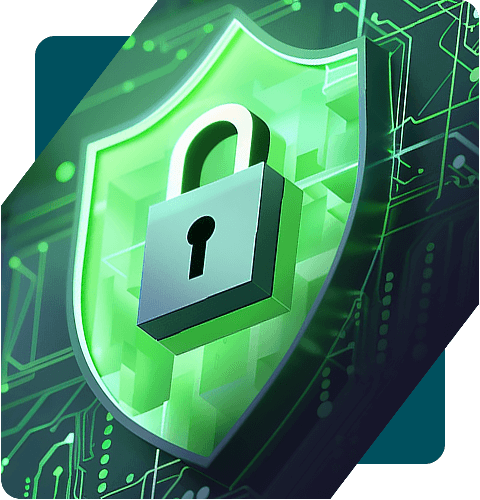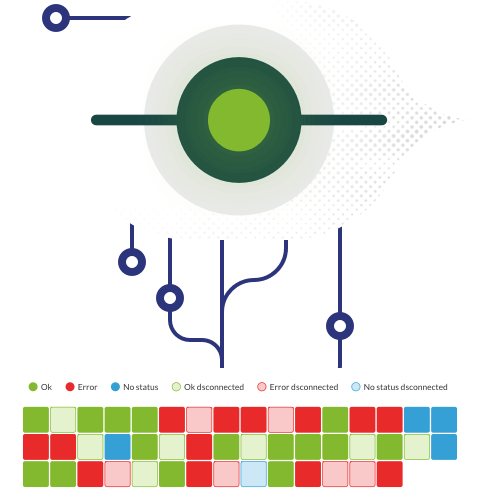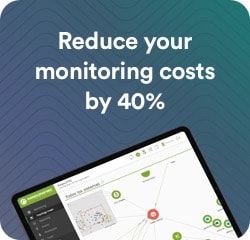Sections
- What Is a Security Operations Center (SOC)?
- Types of SOCs
- Key Functions of a SOC
- Core Components of a SOC
- SOC Integration with Security Technologies
- Why Implement a SOC
- SOC as a Service (SOCaaS): Advantages and Use Cases
- Common Challenges in Managing a SOC
- Best Practices for an Effective SOC
- How Does Pandora SIEM Optimize SOC Management?
- Emerging Trends in SOC
Because those 600 million are not losses—they represent the number of daily attacks targeting Microsoft users alone, according to Microsoft’s own data. Add to that the fact that the Internet basically runs on Linux (plus the four and a half of us who use it on desktop), not to mention Android, macOS, and iOS (and no, they are not immune either).
But numbers alone do not convey the importance of a SOC quite like that gut-wrenching feeling you get when faced with a ransomware screen or the realization of a fraudulent transaction that wiped you out.
To avoid that, here is what you need to know.
What Is a Security Operations Center (SOC)?
A specialized team that uses technologies and processes to monitor, detect, and respond to cybersecurity incidents in real time. Unlike a NOC (Network Operations Center), which focuses on network availability and performance, the SOC prioritizes identifying breaches and neutralizing threats.
You could think of the SOC as the organization’s “immune system” that, through multiple techniques and solutions, actively monitors the attack surface and mitigates breaches. We would not get on a crowded subway without our immune system—but many organizations operate daily without a SOC in place.
The key word is “proactivity”, because a reactive approach is no longer enough—especially when that 292 from earlier represents, according to IBM, the average number of days it takes to contain a breach involving, for example, stolen credentials.
Types of SOCs
Depending on their nature, a SOC can be:
- Internal. In this model, the organization hires its own in-house security experts and licenses the necessary tools. It is ideal for companies with sufficient resources and a need for full control.
- Managed (SOCaaS). In this case, the SOC is outsourced as a service, with expert security providers acting as the Security Operations Center. Both personnel and tools are external, which reduces costs and operational complexity.
- Hybrid/Virtual. A combination of the above—aiming to get the best of both worlds by blending internal teams with external services that cover capabilities the organization cannot fulfill on its own.
Key Functions of a SOC
Regardless of its type, an effective SOC must carry out key functions, including:
Security Planning
Every organization is unique—and so is its specific threat model.
That is why the first function of the SOC is to plan and optimize security. This involves developing a tailored threat model, prioritizing risks, and understanding best practices for mitigation.
Continuous Monitoring and Detection
Once threats are identified, the SOC does not wait for them to happen—it monitors 24/7 using log analysis, network traffic inspection, and endpoint activity tracking.
The ability to do this effectively depends on the right tools, such as EDRs (Endpoint Detection and Response) on devices, and SIEMs (Security Information and Event Management) like Pandora SIEM, which centralize information and separate the signal from the noise.
With the current storm of millions of evolving threats every day, using AI and correlation rules is essential to avoid being overwhelmed.
Incident Response
Sooner or later, incidents will happen—whether through phishing, social engineering, or other techniques. That is why the SOC must lead the response to contain, eradicate, and recover the affected infrastructure.
The goal is to minimize losses and ensure service continuity, both internally and for clients, in order to avoid jeopardizing SLAs (Service Level Agreements).
Likewise, the SOC is responsible for reporting incidents to the appropriate authorities (such as notifying a data breach to the Data Protection Agency) to ensure legal compliance and avoid adding fines to the damages.
Forensic Analysis
Patching the breach and cleaning up the aftermath is not enough. A forensic analysis must be carried out to investigate exactly what happened and implement measures to prevent it from happening again.
Compliance with Security Regulations
This includes overseeing compliance with regulations such as the GDPR for data protection or the European NIS2 directive on cybersecurity. Due to an increasingly demanding legal landscape, this SOC function is becoming more critical to avoid penalties.
Similarly, the SOC leads the implementation of any other applicable standards, such as ISO 27001.
Core Components of a SOC
A SOC is made up of both people and tools. The latter are far more sophisticated than traditional antivirus software, and the former are increasingly specialized—because cybersecurity is a field that never stands still.
Human Components of the SOC
The CISO (Chief Information Security Officer) is the commanding officer. They design and oversee security and risk policies, typically reporting directly to executive leadership.
The CISO is ultimately responsible for failures and the unsung hero behind successes—because in security, you win when you do your job so well that nothing happens (which is also when executives start wondering whether security is even necessary, since no danger seems to be present).
The SOC Manager is responsible for the day-to-day operations within the SOC and for executing the directives set by the CISO, to whom they report.
If you are reading this, chances are you have seen Star Trek: TNG. Think of Captain Picard as the CISO—the one who gives the orders and sets the strategy—while Commander Riker is the SOC Manager, the first officer who executes and takes action.
Then you have the technical personnel working in the trenches, battling malicious actors with tools and grit. An ideal SOC would include:
- Threat Intelligence Team. Proactively investigates malicious actors, techniques, and trends to stay ahead of threats.
- Security Engineers. Responsible for configuring and maintaining tools such as VPNs, potential BYOD environments, and Pandora SIEM—ensuring correlation rules are up to date and systems are running smoothly.
- SOC Analysts. With varying levels of responsibility based on experience. Tasks range from basic alert monitoring (e.g., multiple failed login attempts), to incident investigation (like lateral movement in the network using Mimikatz), to advanced threat hunting for undetected anomalies (e.g., DNS traffic exfiltrating data).
The specific structure of these human components depends on the methodology in place—and more importantly, the budget. This represents the ideal setup, but in many SOCs, it’s not unusual for the official job title to be CISO and the unofficial one to be jack-of-all-trades.
Technological Components of the SOC
The SOC’s mission would be impossible without specialized tools, and its primary technological “weapons” include:
- SIEM (such as Pandora SIEM). The central nervous system that adds and correlates events (e.g., detecting suspicious login attempts combined with lateral movement).
- SOAR (Security Orchestration, Automation, and Response). This system performs automated mitigation actions (such as blocking a malicious IP after a firewall alert).
- EDR (Endpoint Detection and Response). Software that provides advanced protection on organizational endpoints against malware and suspicious actions—such as massive data copying on a device followed by transmission to unknown servers.
SOC Integration with Security Technologies
In the tech world, it often seems like mastering a tool is more important than understanding the processes behind it. While that is not entirely true, it is essential to understand how SOC’s work integrates with the applications designed to support it.
SIEM and SOC
The SOC’s decisions are only as good as the information it receives. That is where the SIEM comes in—aggregating and normalizing logs from various sources (firewalls, servers, applications…) and identifying attack patterns through correlation rules.
For example, the firewall log records multiple connections from the same IP address in a short period. Meanwhile, the server log shows numerous failed authentication attempts for an admin account.
SIEM correlates these events and determines it’s a brute-force attack—triggering a real-time alert to the SOC.
SOAR
This is a technology designed to manage a high volume of security alerts more efficiently. It improves the speed and accuracy of incident response by automating countermeasures, allowing security teams to focus on more strategic tasks.
For example, the SIEM detects a sudden, massive flow of SYN packets originating from IPs in numerous countries. The SOAR system initiates the automated response defined in the “DDoS Mitigation” playbook, under SOC supervision. It redirects traffic to Cloudflare, blocks the IPs, and generates a Jira ticket—without any human intervention.
The attack is mitigated instantly, whereas doing it manually might take an engineer 45 minutes—time better spent on higher-value tasks than repeating this routine process.
EDRs
These are the SOC’s eyes and ears on the organization’s endpoints. They log activity, connect with the SIEM, and can trigger SOAR playbooks automatically while alerting the SOC team.
For instance, a laptop connects to an unknown server and begins sending a large volume of data to a suspicious IP. The EDR detects this and triggers a response in the integrated security system, such as an automated anti-exfiltration process.
Why Implement a SOC
The first reason is simple: survival. According to VikingCloud’s 2025 SMB Threat Landscape report, a single incident can be enough to shut down 1 in 5 small and mid-sized businesses if losses reach $10,000—a figure easily attainable when factoring in direct costs and potential fines for regulatory noncompliance.
There’s a widely cited statistic, often attributed to the National Cybersecurity Alliance and echoed even by major media outlets, that claims 60% of small businesses close after a cyberattack—but this figure is inaccurate.
Still, survival is not the only reason to implement a SOC. A Security Operations Center also delivers:
- Risk reduction
- Increased customer trust
- Regulatory compliance
- SLA fulfillment and continuity of critical services
Of course, all of this may sound idealistic or out of reach—something only large enterprises can afford. But that’s no longer true. Like nearly everything today, a SOC can also be hired as a service.
SOC as a Service (SOCaaS): Advantages and Use Cases
Security often feels like a footnote for many organizations—handed off to the manager’s brother-in-law or the intern who “knows about computers.” The previously mentioned VikingCloud report confirms this suspicion, revealing that 74% of small and mid-sized businesses manage security without adequate expertise.
This is where SOCaaS comes in—a model in which an external provider manages security operations using its own tools and experts in exchange for a subscription.
This approach offers several advantages:
- Reduced cost: No infrastructure investment (e.g., SIEM licenses) or in-house training required.
- Scalability: Easily adjusts to threat spikes (e.g., ransomware campaigns).
- Access to specialized talent: 24/7 analysts with experience in APTs and compliance frameworks, for example.
SOCaaS is especially useful in scenarios such as:
- SMBs without the budget for an internal SOC.
- Urgent regulatory compliance (e.g., ISO 27001 or GDPR).
- Deploying unfamiliar technologies (e.g., migrating to the cloud after relying on on-premises infrastructure).
SOCaaS can also be hybrid-integrated with your internal security architecture. For instance, it could monitor your AWS cloud environment while an on-prem SIEM like Pandora handles local networks. The integration would allow both systems to correlate alerts in a unified dashboard—leveraging telemetry for comprehensive security management.
Common Challenges in Managing a SOC
While every SOC handles a different threat model, the challenges they face tend to be similar:
- Lack of qualified personnel. Especially considering how broad cybersecurity is—and how quickly it evolves every day.
- Alert overload. Which requires automation to separate the signal from the noise, so engineers don’t waste time chasing false positives while a RAT has been hiding in the system for weeks.
- Cost. Because while the CISO answers to the board, in reality, we all answer to the budget. Strong security requires investment—which explains the rise of models like SOCaaS.
Best Practices for an Effective SOC
There is a wide difference between having a SOC and having an effective SOC—and that difference lies in the application of best practices. The human team and software licenses are useless without the right strategies and clear principles, such as:
- A proactive security approach something worth emphasizing over and over.
- Proper threat modeling.
- Clearly defined security processes based on the above model.
- Automation wherever possible for repetitive tasks and common incidents, such as DDoS attacks.
- Ongoing training, since the creativity of malicious actors in developing new hacking techniques seems powered by an infinite energy source.
- A structured and methodical response, aligned with proven frameworks like MITRE ATT&CK, rather than reacting ad hoc.
How Does Pandora SIEM Optimize SOC Management?
Technology should make life easier—and good technology reflects best practices. These are the core guiding principles behind Pandora SIEM, which shoulders the heaviest burdens of a SOC’s wide-ranging responsibilities through:
Advanced Event Correlation
By aggregating logs from firewalls, endpoints, applications, and more—and applying rules based on the MITRE ATT&CK framework—Pandora SIEM can instantly detect and alert on security incidents.
For example, a failed login attempt followed by the execution of obfuscated PowerShell would trigger a malware alert.
Automated Response
Pandora SIEM allows the creation of a comprehensive incident response plan, defining which events require human intervention and which can be handled automatically—giving the SOC team more time and peace of mind.
Customization and Adaptability
Whether it’s rule sets, advanced correlations, or dashboards—Pandora SIEM can be tailored to reflect the specific needs of your SOC.
Similarly, it doesn’t matter if everything is on-premises or if cloud environments like Azure need to be monitored—Pandora SIEM adapts to both and unifies them under a single view.
Incident Lifecycle Tracking
From early alerts to final reports, Pandora SIEM delivers all the necessary information—whether for the SOC’s optimal performance or for regulatory compliance, such as audit requirements under the European NIS2 directive, for example.
Easy Operation and Cutting-Edge Technology
If you already use Pandora FMS, enabling the SIEM server is just “one click” away—ensuring that the latest techniques and technologies are on your side in the fight for cybersecurity.
Emerging Trends in SOC
Malicious actors and cybersecurity professionals are locked in an endless game of cat and mouse—one that changes by the minute, driven by the ingenuity of hackers and the emergence of increasingly complex technologies. This now includes AI, which has entered the battlefield, fighting on both sides.
As a result, two specialized SOC subtypes are beginning to emerge among current trends:
NSOC (Network Security Operations Center), focused on security, monitoring, and intrusion detection at the network level—where much of today’s cyber conflict has shifted.
IDOC (Intelligent Digital Operations Center), which combines IT operations and security, with automation, optimization, and predictive capabilities.
The IDOC aims to fulfill a long-standing dream of hacker hunters: to change the fundamental dynamics of the conflict. With the help of AI, the goal is for the cat not to simply react to the mouse’s moves—as is traditionally the case—but to predict them and have a response ready before they even occur.
Think Minority Report—but without the movie’s dark implications.
These trends reflect the current cybersecurity landscape: complex, fast-evolving, and now featuring AI-powered terminators in the fray. Trying to manage this environment without a SOC is a nostalgic nod to a simpler past—one that is not coming back.
A well-structured SOC, following the principles laid out here, is not a luxury—it’s a necessity. The stakes are rising, and the regulatory landscape is becoming more demanding in response to this new reality.
Beyond limits, beyond expectations









